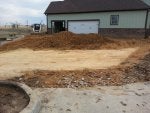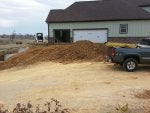Have a one of a king scenario. Customer has 50 year old concrete driveway with a cubing on both sides. Existing driveway is 6 inches below grade. He wants the curbing removed and the new driveway poured directley on top of the old concrete. Good idea or bad idea? Your thoughts. Existing drive is cracked, but not heaving. my concrete supplier wants me to cover the existing concrete with 30 lb. roofing felt then pour a 6 inch drive on top.

Pouring new driveway on top of old driveway
Brock
1 - 14 of 14 Posts
Have a one of a king scenario. Customer has 50 year old concrete driveway with a cubing on both sides. Existing driveway is 6 inches below grade. He wants the curbing removed and the new driveway poured directley on top of the old concrete. Good idea or bad idea? Your thoughts. Existing drive is cracked, but not heaving. my concrete supplier wants me to cover the existing concrete with 30 lb. roofing felt then pour a 6 inch drive on top.
everything always seems to sink and go below grade. why not put in 4" of rock and some plastic, and pour your 6" on that? then you'll really have some isolation and only be 4" above grade.
what do you have planned up next to the garage?
what do you have planned up next to the garage?
Joined
·
9,409 Posts
Take a good look at the cracks that are there, if you pour over them that is where the new slab will crack.
If you could pulverise the existing in place and also isolate the new slab with a layer of stone and poly sheet, (as Cleveman suggests), you will probably have a lasting finished product.
If you could pulverise the existing in place and also isolate the new slab with a layer of stone and poly sheet, (as Cleveman suggests), you will probably have a lasting finished product.
I think pulverizing is the safest bet. We don't use poly in these parts on driveways. I have seen seen some, but not many, use it underneath basement slabs.Take a good look at the cracks that are there, if you pour over them that is where the new slab will crack.
If you could pulverise the existing in place and also isolate the new slab with a layer of stone and poly sheet, (as Cleveman suggests), you will probably have a lasting finished product.
Oh we are leveling the existing 24 x 24 dettached garage and replacing with a 24 x 62 garage/indoor pool/studio.what do you have planned up next to the garage?
It is 80 years old and way below grade now anyway. This is and old, but upscale area. A lot of the old hitchin' posts are still in the yards from days gone by.
OK, then you won't have a grade problem at the garage. Hopefully no other possible grade problems.
I like the poly because it slows the cure, not just because of the isolation. It costs next to nothing.
I like the poly because it slows the cure, not just because of the isolation. It costs next to nothing.
The dissenting voice (mine) says from experience, demo the old, prepare the new like it is the first time, and all will be well.
Joined
·
3,432 Posts
It is very obvious -
Tear out the existing old driveway. Use the recycled driveway or new base to get the correct elevation and our a new driveway where it should be.
Use the appropriate mix and wire for your climate. Saw the control joints late the same day or very early the next day. If you have freezing, use air entrained concrete with a 3" - 5" slump. For a driveway, in some areas (like here in Minnesota), you may not get ANY concrete or a guarantee from the R/M supplier unless the use 4000 psi or so depending on the area.
Poly under a driveway is rediculous and a waste of time - not like an interior slab. The poly can prevent the bottom of the slab from curing as fast as the top. This is a classic case of "curling", which causes the edges to rise and water to be held in the center (birdbaths).
If the customer is a long time customer with future potential, give him a good job. If he is insistant, let him decide what he wants and follow his specification/methods, but make sure you let him know that it is his decision.
Tear out the existing old driveway. Use the recycled driveway or new base to get the correct elevation and our a new driveway where it should be.
Use the appropriate mix and wire for your climate. Saw the control joints late the same day or very early the next day. If you have freezing, use air entrained concrete with a 3" - 5" slump. For a driveway, in some areas (like here in Minnesota), you may not get ANY concrete or a guarantee from the R/M supplier unless the use 4000 psi or so depending on the area.
Poly under a driveway is rediculous and a waste of time - not like an interior slab. The poly can prevent the bottom of the slab from curing as fast as the top. This is a classic case of "curling", which causes the edges to rise and water to be held in the center (birdbaths).
If the customer is a long time customer with future potential, give him a good job. If he is insistant, let him decide what he wants and follow his specification/methods, but make sure you let him know that it is his decision.
I agree, I've been down this road myself & I vividly/painfuly remember almost all the cracks & other misc. flaws that existed in the original slab mirrored right through the new slab.The dissenting voice (mine) says from experience, demo the old, prepare the new like it is the first time, and all will be well.
Need Help on New/Old/Sloped Pour
I have another crazy/unique pour. I'm GC'ing my house (2nd house) and need to connect my garage pad to my old driveway (it's over 600' of concrete, so starting over is not an option). The garage pad will connect to a new pour which terminates at a curved 3' wide cut on one corner, a curb on another corner and another 3' wide cut going down the hill. The old driveway is about 3' below the entrance to the garage, but concrete was removed from the garage going about 4' away from the garage. That's where the old concrete starts and continues.
The dirt you see piled up in the middle is on top of the old drive. My question is, what do you concrete pros recommend, short of removing all the old concrete (not affordable/option) in terms of rebar, substrate, control joints, mix, gravel, etc to give us the best chance at crack and settling mitigation, etc?
I have another crazy/unique pour. I'm GC'ing my house (2nd house) and need to connect my garage pad to my old driveway (it's over 600' of concrete, so starting over is not an option). The garage pad will connect to a new pour which terminates at a curved 3' wide cut on one corner, a curb on another corner and another 3' wide cut going down the hill. The old driveway is about 3' below the entrance to the garage, but concrete was removed from the garage going about 4' away from the garage. That's where the old concrete starts and continues.
The dirt you see piled up in the middle is on top of the old drive. My question is, what do you concrete pros recommend, short of removing all the old concrete (not affordable/option) in terms of rebar, substrate, control joints, mix, gravel, etc to give us the best chance at crack and settling mitigation, etc?
Attachments
-
203 KB Views: 2,304
-
202.7 KB Views: 3,010
-
200.7 KB Views: 2,582
-
203.1 KB Views: 1,596
-
200.2 KB Views: 1,450
Piers and Hammer Drilling Rebar
I'm also curious where and what spacing you'd recommend piers - and any other pier-related info. And some of the new concrete will be poured against the brick retaining wall, new concrete retaining wall, house foundation and garage pad. Do you recommend hammer drilling rebar every so often (what spacing)? And why/why not?
I'm also curious where and what spacing you'd recommend piers - and any other pier-related info. And some of the new concrete will be poured against the brick retaining wall, new concrete retaining wall, house foundation and garage pad. Do you recommend hammer drilling rebar every so often (what spacing)? And why/why not?
Joined
·
4,730 Posts
The poly for this application is just to act as a bond breaker.I think pulverizing is the safest bet. We don't use poly in these parts on driveways. I have seen seen some, but not many, use it underneath basement slabs.
If you are confident that the base under the old driveway is good then you should be able to pull it off no problem, just make sure you cut it similar to how the old one is cracked.
Tear out the old concrete. Do not use poly for an exterior application.
Old topic raised from the grave! Interesting content though.
1 - 14 of 14 Posts
-
?
-
?
-
?
-
?
-
?
-
?
-
?
-
?
-
?
-
?
-
?
-
?
-
?
-
?
-
?
-
?
-
?
-
?
-
?
-
?
- posts
- 3.6M
- members
- 169K
- Since
- 2003
A forum community dedicated to professional construction and remodeling contractors. Come join the discussion about the industry, trades, safety, projects, finishing, tools, machinery, styles, scales, reviews, accessories, classifieds, and more!
Explore Our Forums








